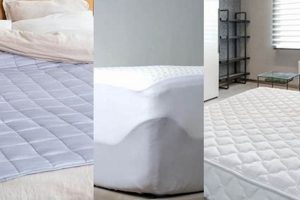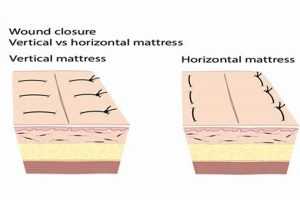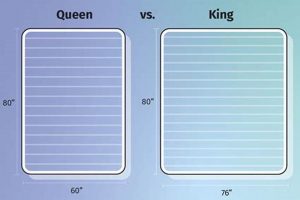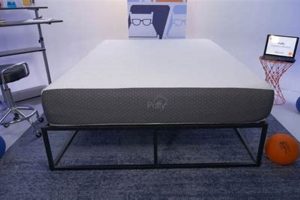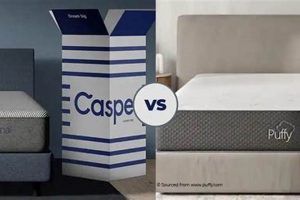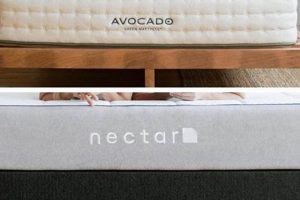The comparison between Nectar and Tempur-Pedic mattresses centers on two prominent brands in the memory foam mattress market. Each offers distinct construction, materials, and features aimed at providing a comfortable and supportive sleep experience. Understanding the nuances between these options allows consumers to make informed purchasing decisions based on their individual needs and preferences.
These mattresses represent a significant advancement in sleep technology, offering pressure relief and motion isolation that traditional innerspring mattresses often lack. The popularity of memory foam mattresses has grown substantially over the past several decades, driven by their potential to alleviate discomfort and improve sleep quality. Consequently, brands have emerged, each with proprietary formulations and design approaches.
This article will delve into a comparative analysis of these popular mattresses, focusing on key aspects such as construction, firmness levels, temperature regulation, price point, and overall customer satisfaction. By examining these characteristics, individuals can gain a clearer perspective on which option best aligns with their specific requirements and expectations for a quality sleep surface.
Choosing between Nectar and Tempur-Pedic mattresses requires careful evaluation of individual needs and preferences. The following tips provide guidance for making an informed decision.
Tip 1: Assess Firmness Preference: Nectar mattresses typically offer a medium-firm feel, while Tempur-Pedic models range from soft to extra-firm. Consider preferred sleeping position and body weight to determine the appropriate firmness level for optimal support and comfort.
Tip 2: Evaluate Temperature Regulation: Memory foam can retain heat. Examine the cooling technologies incorporated into each mattress, such as gel infusions or breathable covers, to mitigate potential overheating during sleep. Individuals prone to night sweats should prioritize models with enhanced cooling features.
Tip 3: Compare Construction Materials: Nectar mattresses generally utilize multiple layers of memory foam with a quilted cover, whereas Tempur-Pedic incorporates its proprietary TEMPUR material. Analyze the density and composition of each layer to understand its impact on pressure relief and durability.
Tip 4: Review Motion Isolation Capabilities: Memory foam excels at isolating motion, minimizing disturbances from a sleeping partner. Test the motion isolation properties of each mattress to ensure undisturbed sleep, particularly if sharing the bed with someone who moves frequently.
Tip 5: Consider Budget Constraints: Nectar mattresses typically offer a more affordable price point compared to Tempur-Pedic models. Establish a budget and compare the features and benefits offered by each brand within that range. Factor in potential financing options or promotional offers.
Tip 6: Check Warranty and Trial Period: Both Nectar and Tempur-Pedic offer warranties and trial periods. Scrutinize the terms and conditions of each to understand the coverage provided and the return policy. A longer trial period allows for a more thorough assessment of the mattress’s suitability.
Tip 7: Read Customer Reviews: Gather insights from other consumers who have purchased and used Nectar or Tempur-Pedic mattresses. Pay attention to recurring themes and address any concerns or questions before making a decision. Real-world experiences provide valuable information regarding long-term performance and satisfaction.
These tips provide a framework for comparing two leading mattress brands, but the ideal choice ultimately depends on specific sleep needs and preferences. A comprehensive evaluation will lead to a selection that promotes restorative and comfortable sleep.
The subsequent sections will delve deeper into specific aspects of these mattresses, providing a more nuanced understanding to aid in the decision-making process.
1. Firmness Options
Firmness options constitute a crucial differentiating factor when considering the comparison between Nectar and Tempur-Pedic mattresses. Mattress firmness directly affects spinal alignment, pressure point relief, and overall sleep comfort. Discrepancies in firmness level offerings between brands influence the target consumer base and suitability for various sleep styles. For instance, side sleepers often require a softer mattress to alleviate pressure on the shoulders and hips, while stomach sleepers generally benefit from a firmer surface to prevent spinal misalignment. The limited firmness range typically found in Nectar mattresses caters primarily to those preferring a medium-firm feel, whereas Tempur-Pedic’s broader spectrum of firmness options accommodates a wider array of sleep preferences and body types. This difference stems from variations in internal construction, foam density, and design philosophy.
The correlation between perceived firmness and actual support is not always linear. Higher density foams, like those frequently used in Tempur-Pedic models, may provide substantial support even in softer configurations. In contrast, a less dense, medium-firm Nectar mattress may lack sufficient support for heavier individuals or those with pre-existing back problems. Therefore, prospective buyers must consider body weight and specific support needs in conjunction with subjective firmness preference. The consequences of selecting an inappropriate firmness level range from minor discomfort and restless sleep to chronic pain and musculoskeletal issues. Mattress retailers frequently offer firmness guides or sleep consultations to assist consumers in navigating these considerations, underscoring the practical significance of understanding firmness options.
Ultimately, the availability of varied firmness options, or the lack thereof, significantly shapes the competitive landscape between these brands. Tempur-Pedic’s diverse range positions it to address a wider segment of the market, while Nectar’s focused approach targets a specific comfort niche. Individuals prioritizing tailored support and pressure relief may find Tempur-Pedic’s offerings more appealing, despite the potentially higher price point. Conversely, consumers seeking a standardized, medium-firm feel at a lower cost might favor Nectar. The challenge lies in aligning individual requirements with the available options, highlighting the importance of thorough research and, ideally, in-person testing prior to purchase.
2. Material Composition
The comparison between Nectar and Tempur-Pedic mattresses hinges significantly on their respective material compositions. The internal architecture and constituent materials directly influence the mattress’s performance characteristics, including firmness, support, temperature regulation, and durability. Nectar mattresses generally employ multiple layers of memory foam, often incorporating gel infusions for cooling and a quilted cover for enhanced comfort. The specific densities and thicknesses of these foam layers contribute to the overall feel and support profile. Conversely, Tempur-Pedic mattresses utilize their proprietary TEMPUR material, a viscoelastic foam designed to conform precisely to the body’s contours, offering targeted pressure relief. The unique cellular structure of TEMPUR material is intended to distribute weight evenly, reducing stress on pressure points. The distinct materials used in each mattress have a causal relationship with their respective performance attributes and perceived value. For instance, TEMPUR material is often associated with superior motion isolation and longevity compared to conventional memory foam, justifying its higher price point.
Examining real-life examples illustrates the practical significance of material composition. Consider a consumer experiencing chronic back pain. A Tempur-Pedic mattress, with its dense TEMPUR material, may provide more effective spinal alignment and pressure relief than a Nectar mattress, potentially alleviating pain and improving sleep quality. Conversely, an individual sensitive to off-gassing odors may find Nectar’s CertiPUR-US certified foams more appealing due to their reduced VOC emissions. The long-term performance of these mattresses is also dictated by material composition. Higher-density foams, like those in Tempur-Pedic models, tend to resist sagging and retain their shape over extended periods, contributing to greater durability. Lower-density foams may be more susceptible to compression and degradation, potentially shortening the mattress’s lifespan. The strategic selection and arrangement of materials within each mattress represent a deliberate design choice, intended to optimize specific performance characteristics and cater to distinct consumer preferences.
In summary, the material composition serves as a foundational element in the comparison between these mattresses. Variations in foam density, the inclusion of proprietary materials like TEMPUR, and the presence of cooling infusions directly impact the comfort, support, durability, and overall value proposition of each mattress. Understanding these material differences enables consumers to make informed purchasing decisions, aligning their choice with individual needs, preferences, and budgetary constraints. While both brands offer memory foam mattresses, the nuances in material composition account for the significant disparities in performance and perceived quality.
3. Temperature Regulation
Temperature regulation is a critical performance characteristic in mattresses, directly impacting sleep comfort and quality. Memory foam, a primary component in both Nectar and Tempur-Pedic mattresses, is known for its heat-retentive properties. This can lead to discomfort for sleepers who tend to overheat during the night. Mattress manufacturers address this issue through various design and material innovations intended to dissipate heat and promote airflow. A mattress’s capacity to effectively regulate temperature is a significant factor in overall customer satisfaction.
In the context of the comparison between Nectar and Tempur-Pedic mattresses, temperature regulation strategies differ. Nectar often incorporates gel-infused memory foam layers, aiming to draw heat away from the sleeper’s body. Tempur-Pedic, on the other hand, may utilize proprietary materials and open-cell foam structures, designed to enhance breathability and prevent heat build-up. Real-life examples illustrate the importance of these features. Individuals residing in warmer climates, or those prone to night sweats, may find that a mattress with superior temperature regulation is essential for maintaining a comfortable sleep environment. The absence of adequate cooling features can result in disrupted sleep, increased tossing and turning, and an overall decrease in sleep quality.
Ultimately, the effectiveness of temperature regulation features varies between models and brands. While both Nectar and Tempur-Pedic employ strategies to mitigate heat retention, the subjective experience can differ based on individual physiology, ambient temperature, and bedding choices. The practical significance of understanding temperature regulation in these mattresses lies in the ability to select a product that aligns with personal needs and environmental conditions. Overlooking this aspect can lead to discomfort and dissatisfaction, underscoring the importance of researching and comparing the cooling capabilities of different mattress options.
4. Motion Isolation
Motion isolation is a critical factor in assessing the comparative value of Nectar and Tempur-Pedic mattresses, particularly for individuals sharing a bed. This characteristic refers to a mattress’s ability to minimize the transfer of movement from one area of the sleeping surface to another. The underlying mechanism for motion isolation lies in the material properties of the mattress and its internal construction. Memory foam, a primary component in both Nectar and Tempur-Pedic mattresses, inherently possesses excellent motion isolation capabilities due to its viscoelastic nature. When pressure is applied to one area, the foam absorbs and dampens the movement, preventing it from propagating to other areas of the mattress. This effect is especially beneficial for light sleepers or those who are easily disturbed by a partner’s movements during the night.
In the context of Nectar versus Tempur-Pedic, differences in motion isolation performance can arise from variations in foam density and composition. Tempur-Pedic’s proprietary TEMPUR material, known for its high density and conforming properties, often exhibits superior motion isolation compared to the more generic memory foam used in Nectar mattresses. For example, if one partner gets out of bed during the night, the other partner is less likely to feel the disturbance on a Tempur-Pedic mattress due to the enhanced motion-dampening characteristics of the TEMPUR material. Conversely, while Nectar mattresses also provide adequate motion isolation, the slightly less dense foam may allow for a greater degree of movement transfer, particularly with heavier individuals or more restless sleepers. This distinction is not merely theoretical; user reviews and independent testing often corroborate the superior motion isolation performance of Tempur-Pedic mattresses, albeit at a higher price point.
The practical significance of understanding motion isolation in the context of these mattresses is considerable. Individuals who prioritize undisturbed sleep and share a bed with a partner who moves frequently should carefully consider this feature. While both Nectar and Tempur-Pedic offer motion isolation, the degree to which they achieve this can influence overall sleep quality and satisfaction. The higher cost of Tempur-Pedic may be justified for those who place a premium on minimizing sleep disruptions caused by movement. Ultimately, the choice depends on individual needs, budget, and tolerance for movement transfer. Careful consideration of motion isolation capabilities, combined with other factors such as firmness, temperature regulation, and support, contributes to a well-informed mattress purchase.
5. Price Range
The price range represents a significant point of divergence when considering mattress options. This factor not only influences accessibility but also reflects perceived value and material quality. The comparison between Nectar and Tempur-Pedic mattresses highlights a clear contrast in pricing strategies.
- Entry-Level Accessibility
Nectar mattresses are generally positioned as a more affordable option, appealing to budget-conscious consumers. This accessibility stems from a direct-to-consumer business model and a focus on cost-effective materials. Conversely, Tempur-Pedic mattresses occupy a premium segment, reflecting higher material costs and established brand recognition. The price disparity creates different entry points into the memory foam mattress market, enabling consumers to select based on their financial constraints.
- Material Composition and Cost
The underlying materials contribute substantially to the pricing differences. Tempur-Pedic utilizes its proprietary TEMPUR material, the production of which involves advanced technologies and higher costs. Nectar, while using memory foam, typically employs more conventional formulations, resulting in lower material expenses. The specific composition and density of the foam directly impact the mattress’s price point, influencing the overall value proposition.
- Brand Perception and Value
Brand reputation plays a pivotal role in pricing strategies. Tempur-Pedic has cultivated a strong brand image associated with quality and durability, justifying a premium price. Nectar, as a relatively newer brand, often relies on competitive pricing and promotional offers to gain market share. Consumers may be willing to pay more for a Tempur-Pedic mattress based on perceived longevity and brand trust, even if the functional differences are marginal.
- Long-Term Cost Considerations
While the initial price may be a primary factor, long-term cost considerations are also relevant. A more durable Tempur-Pedic mattress may prove more cost-effective over time compared to a less expensive Nectar mattress that requires replacement sooner. Warranty coverage and potential maintenance costs should be factored into the overall assessment. The relationship between initial price and long-term value contributes to the complexity of the purchase decision.
Ultimately, the price range serves as a crucial differentiator in the comparison between Nectar and Tempur-Pedic mattresses. It reflects not only the material costs and brand perception but also the target consumer base and overall value proposition. Understanding these nuances allows consumers to make informed choices that align with their budgetary constraints and long-term expectations.
6. Warranty Coverage
Warranty coverage represents a significant element in the overall value proposition when comparing Nectar and Tempur-Pedic mattresses. A mattress warranty serves as a manufacturer’s assurance regarding product quality and durability, protecting consumers against defects in materials and workmanship. The specific terms and conditions of a warranty can vary substantially between brands, influencing the perceived risk associated with the purchase. In the context of Nectar versus Tempur-Pedic, disparities in warranty duration, coverage scope, and claims processes can impact consumer confidence and long-term satisfaction. For example, a longer warranty period suggests greater manufacturer confidence in the product’s lifespan, while clearly defined coverage protects against specific issues, such as sagging or indentations exceeding a certain threshold.
The practical implications of warranty coverage become evident in situations involving product defects. If a Nectar mattress develops significant sagging within the warranty period, a consumer can file a claim with the manufacturer, potentially receiving a replacement or repair. Similarly, a Tempur-Pedic mattress exhibiting premature degradation of the TEMPUR material would be subject to warranty assessment and resolution. However, the specific conditions under which such claims are valid are crucial. Warranties often stipulate requirements regarding the use of appropriate bed frames and mattress protectors, and may exclude damage resulting from misuse or neglect. Therefore, understanding the fine print is essential for ensuring valid warranty coverage. The availability of responsive and efficient warranty support further enhances the consumer experience, facilitating timely resolution of any issues that may arise.
In summary, warranty coverage forms an integral component of the Nectar versus Tempur-Pedic mattress comparison, serving as a safeguard against potential defects and offering peace of mind to consumers. The duration, scope, and claims processes associated with the warranty significantly influence the perceived risk and long-term value of each mattress. Prospective buyers should carefully review and compare the warranty terms offered by both brands, considering their individual needs and expectations for product longevity. While a warranty cannot guarantee complete satisfaction, it provides a critical layer of protection and contributes to a more informed purchasing decision.
Frequently Asked Questions
This section addresses common inquiries regarding the comparison between Nectar and Tempur-Pedic mattresses, providing factual information to assist in the decision-making process.
Question 1: Are Tempur-Pedic mattresses inherently superior to Nectar mattresses?
Superiority is subjective and depends on individual preferences and needs. Tempur-Pedic mattresses generally offer a wider range of firmness options and incorporate proprietary materials like TEMPUR foam, often resulting in enhanced pressure relief and motion isolation. However, Nectar mattresses offer a more budget-friendly alternative with a focus on a medium-firm feel. The optimal choice varies based on specific requirements.
Question 2: Do Nectar and Tempur-Pedic mattresses require specific bed frames?
Both mattress types are compatible with most standard bed frames, including platform beds, slatted frames, and adjustable bases. However, ensuring adequate support is crucial. Slatted frames should have slats spaced no more than a few inches apart to prevent sagging. Consulting the manufacturer’s recommendations regarding bed frame compatibility is advisable.
Question 3: How do the cooling properties of Nectar and Tempur-Pedic mattresses compare?
Both brands incorporate cooling technologies to mitigate heat retention associated with memory foam. Nectar often utilizes gel-infused memory foam layers, while Tempur-Pedic may employ open-cell foam structures or proprietary cooling materials. The effectiveness of these features varies based on individual body temperature and environmental conditions. Reading independent reviews and considering personal cooling preferences is recommended.
Question 4: What is the typical lifespan of Nectar and Tempur-Pedic mattresses?
The lifespan of a mattress depends on factors such as material quality, usage, and maintenance. Tempur-Pedic mattresses, due to their higher density foams, generally exhibit greater durability and may last longer than Nectar mattresses. However, with proper care, both brands can provide several years of comfortable sleep. Following the manufacturer’s care instructions and using a mattress protector can extend the mattress’s lifespan.
Question 5: Are there any known health concerns associated with Nectar or Tempur-Pedic mattresses?
Both brands utilize CertiPUR-US certified foams, indicating that the materials have been tested for harmful chemicals and VOC emissions. Some individuals may experience a temporary off-gassing odor upon initial unboxing, which typically dissipates within a few days. Individuals with chemical sensitivities should research the specific materials used in each mattress and consider consulting with a healthcare professional.
Question 6: What are the key factors to consider when choosing between Nectar and Tempur-Pedic mattresses?
Key considerations include budget, preferred firmness level, temperature regulation needs, motion isolation requirements, and desired lifespan. Evaluating these factors in conjunction with individual sleep preferences will facilitate a more informed decision. Reading independent reviews and, if possible, testing the mattresses in person is highly recommended.
Understanding these frequently asked questions provides a more comprehensive perspective on the nuances between Nectar and Tempur-Pedic mattresses, allowing for a more confident purchase.
The next section will provide a summary that will allow for a more confident purchase.
Nectar vs Tempurpedic Mattress
The preceding analysis has illuminated the critical distinctions between Nectar and Tempur-Pedic mattresses. Key considerations include firmness options, material composition, temperature regulation capabilities, motion isolation effectiveness, price range, and warranty coverage. Each brand caters to a specific segment of the market, with Nectar prioritizing affordability and a standardized medium-firm feel, while Tempur-Pedic emphasizes premium materials, varied firmness choices, and enhanced performance features.
The selection of a sleep surface constitutes a significant investment in personal well-being. It is incumbent upon prospective buyers to conduct thorough research, aligning their choice with individual needs, preferences, and budgetary constraints. The information presented herein serves as a foundation for informed decision-making, promoting the acquisition of a mattress that facilitates restorative sleep and long-term satisfaction. Further investigation, including independent reviews and, where feasible, in-person testing, is strongly encouraged to ensure optimal suitability.


